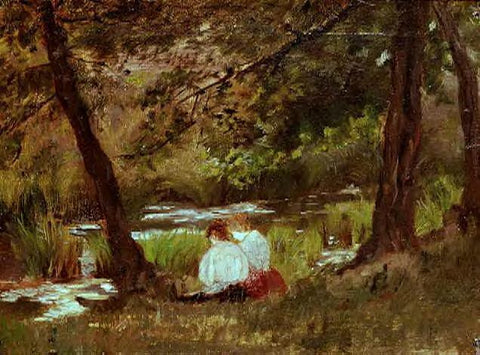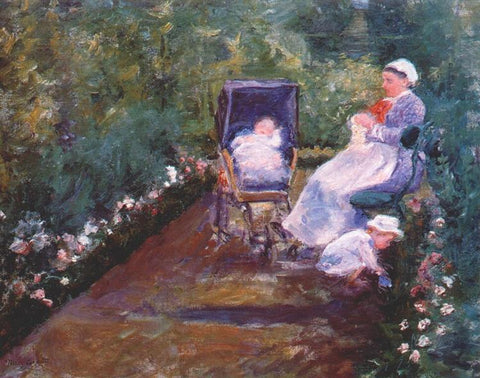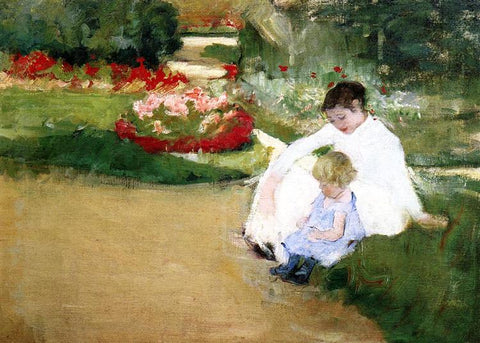As May ushers in its vibrant blooms and gentle warmth, it presents an ideal opportunity to explore the works of Mary Cassatt, an artist renowned for her evocative depictions of intimate, daily moments. Celebrated for her poignant representations of women and children, Cassatt's art beautifully encapsulates the spirit of May, making it a fitting tribute to the season’s themes of growth, renewal, and the nurturing essence of the outdoors. Let’s delve into some of her pieces that beautifully mirror the themes of motherhood, femininity, and the rejuvenating spirit of springtime gardens and flowers.
Reflecting Tranquility: "Two Women Seated by a Woodland Stream"

The Joy of Childhood: "Children in a Garden (The Nurse)"

Children in a Garden (The Nurse)" from 1878 captures the delight of childhood exploration under the watchful eyes of a caregiver. This painting reflects Cassatt’s skill in depicting everyday life and her keen observation of social interactions. The vibrant garden setting, brimming with the freshness of May, serves as a lively backdrop to the child's play. Cassatt’s use of vibrant colors and light in this piece perfectly embodies the vivacity and renewal that spring brings.
The Scent of May: "Lilacs in a Window"

Circa 1880, "Lilacs in a Window" marks Cassatt’s foray into the still life genre, a deviation from her usual focus on figures. This painting is a testament to her versatility and keen eye for beauty in simplicity. The lilacs, placed against the backdrop of a window, bask in natural light, symbolizing the freshness and renewal that May brings. The choice of lilacs, often associated with the first emotions of love, enhances the painting's springtime feel, inviting viewers to breathe in the fragrance of blooming life.
A Moment of Companionship: "Lydia Seated in the Garden with a Dog in Her Lap"

Also from around 1880, "Lydia Seated in the Garden with a Dog in Her Lap" captures a serene moment of companionship and leisure in the outdoors. Lydia, a recurring subject in Cassatt’s works, is portrayed enjoying a peaceful moment with her pet, surrounded by the lush greenery of a garden. This painting not only highlights Cassatt's skill in rendering human and animal figures but also her ability to convey the soothing and therapeutic presence of nature and pets. It’s a celebration of the comfort and quiet joy found in the company of a beloved animal amidst the beauty of a garden in bloom.
A Burst of Color: "Red Poppies"

"Red Poppies," painted between 1874 and 1880, is a vibrant genre painting that marks a departure from Mary Cassatt's usual focus on quiet, personal moments. Instead, this piece captures the wild and untamed beauty of poppies in a field, bringing a burst of outdoor vitality into her repertoire. The painting is distinguished by rich, vivid brushstrokes of red and green, which vividly depict a cluster of red poppies thriving outdoors.
Cassatt's impressionistic style, with its loose brushwork and emphasis on light and movement, animates the poppies, making them appear as if they are swaying in the gentle May breeze. This painting perfectly captures the essence of being outdoors.
Serenity and Connection: "Woman and Child Seated in a Garden"

Painted around 1881, "Woman and Child Seated in a Garden" is a delightful Impressionist piece that depicts a moment of quiet intimacy between a mother and her child in a lush garden setting. This genre painting showcases Cassatt’s exceptional ability to capture the subtle interactions and emotional connections between her subjects.
In this artwork, the garden, vibrant with the greens and colors of spring, serves as both a backdrop and a participant in the scene. The mother holds the child gently, their poses relaxed and natural, suggesting a moment of peaceful coexistence with nature. The light, filtered through the leaves, plays on their faces and clothes, enhancing the feeling of a warm, sunlit day.
Cassatt’s use of light and shadow, along with her soft yet dynamic brushstrokes, conveys not just the visual beauty of the scene but also the warmth of the relationship between the figures. The garden setting is ideal for representing May's themes of renewal and growth, reflecting the nurturing aspect of motherhood intertwined with the rebirth of the natural world.
